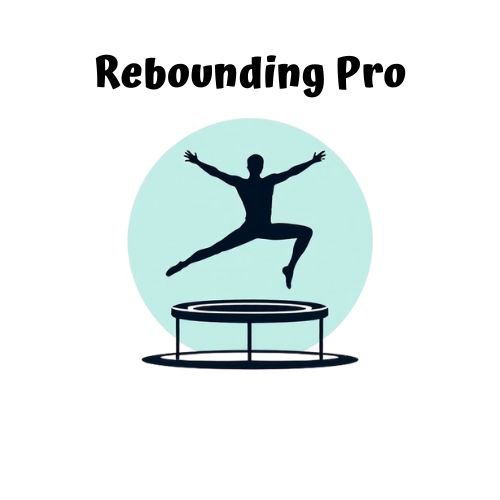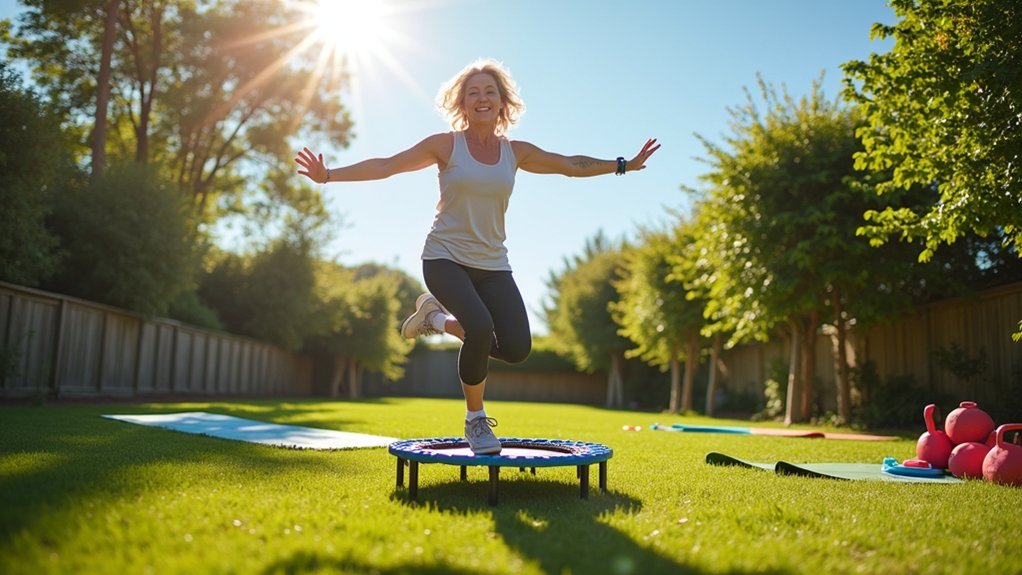Rebounding on a mini-trampoline for just 10 minutes daily dramatically boosts your lymphatic circulation by up to 15 times normal flow. This gentle bouncing creates the ideal G-force alternation your lymph system needs since it lacks its own pump. Start with 2-3 minutes and gradually increase, watching for improvements like reduced puffiness, clearer skin, and increased energy within weeks. The healing benefits extend far beyond what these simple bounces might suggest.
The Science Behind Rebounding and Lymphatic Circulation

While often overlooked in discussions about physical health, the lymphatic system plays an essential role in your body's detoxification and immune defense processes.
Unlike your cardiovascular system, your lymphatic system lacks a natural pump to move fluid throughout your body. This is where rebounding makes a significant difference.
Your lymphatic system has no built-in pump—rebounding creates the movement this crucial network desperately needs.
When you bounce on a mini-trampoline, you create a pumping mechanism that opens and closes lymphatic valves with each jump. This repeated compression and release can increase lymph flow up to 15 times compared to remaining sedentary.
The vertical motion effectively flushes toxins and waste from your tissues while supporting immune function by stimulating white blood cell production. Even a gentle health bounce for just 2-3 minutes once or twice daily can provide significant benefits for lymphatic circulation. It's a simple yet powerful way to overcome the limitations of a system that relies on external forces for peak function.
How G-Force Alternation Powers Detoxification
The remarkable effectiveness of rebounding comes from a fundamental physical principle: G-force alternation. When you bounce, your body experiences rapid shifts between weightlessness at the top of each bounce and increased gravitational force at the bottom. This creates a powerful pumping effect on your lymphatic vessels.
These alternating forces activate mechanoreceptors throughout your lymphatic system, triggering calcium and nitric oxide responses that regulate vessel contractions. The pressure gradients established during rebounding overcome the natural resistance to lymph flow, enhancing circulation through vessels that lack their own pump.
Your body's detoxification processes accelerate as this improved lymphatic flow efficiently removes cellular waste and environmental toxins from your tissues. This low impact exercise provides substantial benefits while being gentle on joints compared to running or high-intensity activities. This mechanical stimulation creates a systemic effect, supporting your immune function and potentially reducing inflammation throughout your body.
Getting Started: Your First Week of Rebounding

Prioritize your safety with a proper warm-up and by using stabilizing handrails during your first week of rebounding.
Start with just 2-3 minutes of gentle bouncing on day one, gradually increasing to 10 minutes by week's end as your body adapts to this unique movement. Remember that maintaining proper form is essential for preventing injuries and maximizing the effectiveness of your rebounding sessions.
You'll quickly discover your natural bouncing rhythm as you alternate between health-bounce (feet staying on the mat) and more energetic movements that elevate your lymphatic cleansing.
Safety First Approach
Before diving into the exhilarating world of rebounding, establishing a solid safety foundation is essential for maximizing benefits while preventing injuries.
Start by selecting a sturdy, fitness-grade rebounder and placing it on a flat surface with adequate ceiling clearance.
Always consult your healthcare provider before beginning, especially if you have existing health conditions.
When starting out, use stability bars or position your rebounder near a wall for support.
Wear comfortable, fitted clothing and begin with just 5-10 minutes per session.
Check your equipment regularly for wear and tear, and never bounce on damaged parts.
Listen to your body—stop immediately if you experience dizziness or discomfort.
As you progress through your first week, gradually increase duration while maintaining proper form with evenly distributed weight.
Maintain an athletic stance position throughout your workout, with hips back and knees slightly bent to ensure proper impact absorption.
Progressive Intensity Schedule
Starting your first week of rebounding requires a carefully structured approach that gradually builds your confidence and stamina.
Begin with two daily 5-minute sessions, one in the morning and another in the evening. Focus on mastering basic bounces before progressing to more complex movements. This approach embraces progressive overload principle which ensures your body adapts safely to this new exercise form.
By mid-week, increase your sessions to 7-8 minutes, incorporating gentle arm movements and side steps to enhance balance and coordination.
Listen to your body—if you're feeling strong, add a minute to your routine; if you're sore, maintain your current level.
Track your progress in a simple journal, noting improvements in energy and comfort.
By week's end, aim for two 10-minute sessions with varied exercises.
Finding Your Bounce
As you commence your rebounding journey, finding your unique bounce rhythm requires patience and awareness of your body's initial response. Begin with 5-10 minute sessions, gradually building to multiple daily sessions as your comfort increases. Maintaining neutral foot placement prevents improper alignment and reduces injury risk during your bouncing sessions.
| Day | Activity | Duration | Focus | Modification |
|---|---|---|---|---|
| 1-2 | Gentle bouncing | 5 min | Balance | Hold stability bar |
| 3-4 | Walking in place | 7 min | Posture | Reduce height |
| 5 | Basic bouncing | 8 min | Breathing | Slower pace |
| 6 | Light jogging | 9 min | Rhythm | March instead |
| 7 | Mixed movements | 10 min | Coordination | Simplify as needed |
Listen to your body and expect some muscle tightness, particularly in your calves. Remember to stretch afterward and maintain proper form—feet hip-width apart, knees slightly bent, and core engaged throughout your session.
Measuring Success: Signs Your Lymphatic System Is Responding

You'll likely notice visible detoxification effects within 2-3 weeks of consistent rebounding, including clearer skin and reduced puffiness.
Your energy recovery time will shorten considerably as your lymphatic system becomes more efficient at clearing metabolic waste.
These physical improvements serve as tangible markers that your lymph flow is responding positively to your rebounding routine. However, individuals with conditions like lymphedema should be cautious, as abnormal lymphatic function is linked to inflammatory disorders and can affect immune response regulation.
Visible Detoxification Effects
When your lymphatic system begins responding to detoxification efforts, your body communicates through clear, observable changes.
You'll notice reduced swelling as excess fluid drains from tissues, particularly in areas prone to water retention like ankles and fingers.
Your skin health improves dramatically—many people report clearer complexion and diminished rashes as toxins exit your system.
Joint pain often subsides as inflammatory compounds are processed and removed, allowing for greater mobility and comfort.
You might experience an enhanced immune response, with fewer colds and quicker recovery from illnesses.
Some people even notice weight loss support as metabolism improves with better lymphatic function.
These visible signs aren't just cosmetic benefits—they're powerful indicators that your body's natural cleansing processes are working efficiently to restore ideal health and balance.
Physical activity is crucial, as inactivity can lead to lymph issues and toxin accumulation that counteract your detoxification efforts.
Improved Energy Recovery
Energetic renewal signals one of the most notable indicators that your lymphatic system has begun responding to your detoxification efforts.
When you consistently stimulate lymph flow through bouncing, you'll notice a dramatic shift in your fatigue levels, often within days.
You'll experience more sustained energy throughout the day, waking refreshed instead of exhausted. Mental fog lifts as toxins clear from your system, replaced by sharper focus and clearer thinking.
This cognitive boost often surprises people who started bouncing primarily for physical benefits.
Your recovery time after workouts will shorten considerably, with less muscle soreness and quicker returns to baseline performance. Regular bouncing helps in the removal of waste products from your tissues, making your recovery process more efficient.
Pay attention to your energy patterns—if afternoon slumps disappear or you're handling stress more efficiently, your lymphatic system is functioning effectively, powering your body's natural healing mechanisms.
Beyond Bouncing: Complementary Practices for Lymphatic Health
While rebounding exercises provide excellent lymphatic stimulation, they represent just one approach in a thorough lymphatic health toolkit.
Complement your bouncing routine with gentle lymphatic massage techniques like the Vodder or Foldi methods, which use precise hand movements to mimic natural lymph flow.
Your diet greatly impacts lymphatic health—prioritize cruciferous vegetables, leafy greens, and omega-3 rich foods while minimizing processed options.
Stay well-hydrated and practice dry brushing before showering for enhanced circulation.
Don't underestimate stress management's role in lymphatic function.
Incorporate yoga, deep breathing exercises, or meditation into your routine.
For a complete approach, consider integrative practices like osteopathic techniques or acupuncture, which can regulate lymph flow when combined with primary movement-based strategies. These complementary treatments help maintain fluid balance between blood and tissues while supporting the body's natural detoxification processes.
Rebounding vs. Traditional Cardio for Lymphatic Drainage
Many fitness enthusiasts face a common question when focusing on lymphatic health: should you choose a mini-trampoline workout or stick with traditional cardio exercises?
Rebounding offers unique lymphatic benefits through its gentle bouncing motion, creating a pumping effect that enhances toxin removal. It's remarkably joint-friendly compared to high-impact activities like running or jogging, making it ideal if you have sensitive joints.
The gentle bouncing of rebounding acts as a natural lymphatic pump, clearing toxins while protecting vulnerable joints from impact stress.
While traditional cardio burns more calories and engages varied muscle groups, it doesn't specifically target lymphatic circulation the way rebounding does. The vertical motion of bouncing efficiently stimulates lymph flow throughout your entire body. Research suggests just 10-15 minutes daily provides effective lymphatic drainage benefits.
For peak lymphatic health, consider your personal needs—if joint protection is important while boosting lymphatic drainage, rebounding may be your better choice.
The convenience of a compact rebounder also means you'll likely stick with it.
Advanced Rebounding Techniques for Maximum Flow
Once you've mastered basic rebounding exercises, advanced techniques can dramatically enhance your lymphatic flow.
Try weight shift jumps by moving from one foot to another while bouncing—this improves balance while stimulating lymphatic circulation.
Add arm movements to your bouncing routine with modified jumping jacks to increase whole-body lymphatic flow.
Split jumps with bent knees target the legs' lymphatic vessels, while rotation jumps move lymph in multiple directions simultaneously.
Vary your intensity during your 10-15 minute sessions to create an ideal pumping effect.
The vertical motion activates the one-way valves in your lymphatic vessels more effectively than horizontal exercises like running.
These advanced techniques not only maximize lymphatic drainage but also improve coordination and cardiovascular fitness without stressing your joints.
Studies show rebounding can stimulate lymph movement up to 4x faster than walking, making it one of the most efficient exercises for lymphatic health.
Healing Stories: Lymphedema Management Through Rebounding
Three remarkable patients have transformed their lymphedema symptoms through consistent rebounding practice.
Sarah, who struggled with arm swelling for years after breast cancer treatment, witnessed a 56% reduction in symptoms after just three months of daily 10-minute sessions on her BCAN rebounder.
Michael, battling leg lymphedema, found relief through seated health bounces when traditional exercise proved too painful. The gentle bouncing effectively opens one-way valves in his lymphatic system, promoting proper fluid drainage without stressing his joints. He gradually built up to 15-minute sessions five times weekly, experiencing improved circulation and considerably decreased swelling.
Emma combined rebounding with her existing treatment plan and saw enhanced results compared to treatment alone.
Starting with gentle two-minute sessions, she's now confidently using her Bellicon 44" for full 15-minute workouts that keep her symptoms manageable without medication adjustments.
Creating Your Year-Round Lymphatic Fitness Plan
Designing a year-round lymphatic fitness plan requires thoughtful integration of various exercises that specifically target your body's natural detoxification system.
Consistency is key—aim for daily rebounding sessions of just 10-15 minutes to maximize lymphatic circulation without overwhelming your schedule.
- Combine rebounding with yoga poses 2-3 times weekly to enhance flexibility and lymphatic flow.
- Stay hydrated by drinking at least 64 ounces of water daily to thin lymph fluid.
- Schedule stress-reduction activities like deep breathing or meditation to complement physical exercise.
- Rotate between higher-intensity rebounding days and gentler movement days for sustainable practice.
Remember to listen to your body and adjust your plan seasonally.
Even short, consistent sessions will yield better results than occasional intense workouts.
Frequently Asked Questions
Can Rebounding Worsen Certain Health Conditions?
Yes, rebounding can worsen back conditions, pelvic floor disorders, and ankle problems. You shouldn't bounce if you have pinched nerves, osteoporosis, sciatica, or pelvic prolapse without consulting your healthcare provider first.
Is Rebounding Safe During Pregnancy?
While rebounding isn't universally safe during pregnancy, you shouldn't bounce. Instead, try gentle, non-bouncing movements with a handlebar for support. Always consult your doctor before starting any exercise during pregnancy.
How Does Altitude Affect Rebounding Benefits?
At higher altitudes, you'll experience reduced oxygen, which may initially decrease your rebounding endurance but could enhance long-term cardiovascular benefits. Your lymphatic system might work harder, potentially maximizing the detoxification effects of rebounding.
Can Children Benefit From Rebounding for Lymphatic Health?
Yes, your children can benefit from rebounding for lymphatic health. It stimulates their developing lymphatic systems, promotes immune function, and improves circulation when they bounce for just 10-15 minutes, 3-5 times weekly.
Will Rebounding Cause Face or Skin Sagging Over Time?
No, rebounding won't cause face or skin sagging. You'll likely experience the opposite effect as it stimulates collagen production, improves circulation, and tones muscles, all of which help maintain skin elasticity and firmness.
In Summary
Your body's natural detox system awaits activation, and rebounding offers the simplest solution. Just 10-15 minutes of daily bouncing can transform your lymphatic health. You'll feel lighter, clearer, and more energized as toxins exit your system more efficiently. Make this gentle yet powerful practice part of your routine, and you'll strengthen not just your lymphatic flow, but your entire immune system for years to come.





Leave a Reply